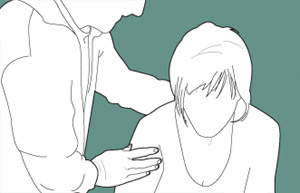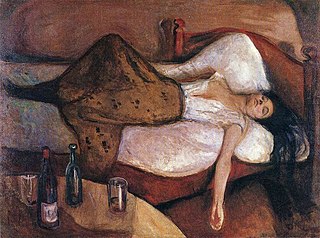Related Research Articles

Anxiety is an emotion which is characterised by an unpleasant state of inner turmoil and includes feelings of dread over anticipated events. Anxiety is different from fear in that fear is defined as the emotional response to a present threat, whereas anxiety is the anticipation of a future one. It is often accompanied by nervous behavior such as pacing back and forth, somatic complaints, and rumination.

Alcoholism is the continued drinking of alcohol despite it causing problems. Some definitions require evidence of dependence and withdrawal. Problematic use of alcohol has been mentioned in the earliest historical records. The World Health Organization (WHO) estimated there were 283 million people with alcohol use disorders worldwide as of 2016. The term alcoholism was first coined in 1852, but alcoholism and alcoholic are sometimes considered stigmatizing and to discourage seeking treatment, so diagnostic terms such as alcohol use disorder or alcohol dependence are often used instead in a clinical context.

A phobia is an anxiety disorder, defined by an irrational, unrealistic, persistent and excessive fear of an object or situation. Phobias typically result in a rapid onset of fear and are usually present for more than six months. Those affected go to great lengths to avoid the situation or object, to a degree greater than the actual danger posed. If the object or situation cannot be avoided, they experience significant distress. Other symptoms can include fainting, which may occur in blood or injury phobia, and panic attacks, often found in agoraphobia and emetophobia. Around 75% of those with phobias have multiple phobias.

Agoraphobia is a mental and behavioral disorder, specifically an anxiety disorder characterized by symptoms of anxiety in situations where the person perceives their environment to be unsafe with no easy way to escape. These situations can include public transit, shopping centers, crowds and queues, or simply being outside their home on their own. Being in these situations may result in a panic attack. Those affected will go to great lengths to avoid these situations. In severe cases, people may become completely unable to leave their homes.

Panic attacks are sudden periods of intense fear and discomfort that may include palpitations, sweating, chest pain or chest discomfort, shortness of breath, trembling, dizziness, numbness, confusion, or a feeling of impending doom or of losing control. Typically, symptoms reach a peak within ten minutes of onset, and last for roughly 30 minutes, but the duration can vary from seconds to hours. Although they can be extremely frightening and distressing, panic attacks themselves are not physically dangerous. Experiencing a panic attack has been said to be one of the most intensely frightening, upsetting, and uncomfortable experiences of a person's life and may take days to initially recover from. Repeated panic attacks are considered a symptom of panic disorder.
Emetophobia is a phobia that causes overwhelming, intense anxiety pertaining to vomit. This specific phobia can also include subcategories of what causes the anxiety, including a fear of vomiting or seeing others vomit. Emetophobes might also avoid the mentions of "barfing", vomiting, "throwing up", or "puking."

Stage fright or performance anxiety is the anxiety, fear, or persistent phobia that may be aroused in an individual by the requirement to perform in front of an audience, real or imagined, whether actually or potentially. Performing in front of an unknown audience can cause significantly more anxiety than performing in front of familiar faces. In some cases, the person will suffer no such fright from this, while they might suffer from not knowing who they're performing to. In some cases, stage fright may be a part of a larger pattern of social phobia, but many people experience stage fright without any wider problems. Quite often, stage fright arises in a mere anticipation of a performance, often a long time ahead. It has numerous manifestations: stuttering, tachycardia, tremor in the hands and legs, sweaty hands, facial nerve tics, dry mouth, and dizziness.
"Hair of the dog", short for "hair of the dog that bit you", is a colloquial expression in the English language predominantly used to refer to alcohol that is consumed as a hangover remedy. Many other languages have their own phrase to describe the same concept. The idea may have some basis in science in the difference between ethanol and methanol metabolism.

Self-stimulatory behavior, also known as "stimming" and self-stimulation, is the repetition of physical movements, sounds, words, moving objects, or other behaviors. Such behaviors are found to some degree in all people, especially those with developmental disabilities such as ADHD, as well as autistic people. People diagnosed with sensory processing disorder are also known to potentially exhibit stimming behaviors.

A hangover is the experience of various unpleasant physiological and psychological effects usually following the consumption of alcohol, such as wine, beer, and liquor. Hangovers can last for several hours or for more than 24 hours. Typical symptoms of a hangover may include headache, drowsiness, concentration problems, dry mouth, dizziness, fatigue, gastrointestinal distress, absence of hunger, light sensitivity, depression, sweating, hyper-excitability, irritability, and anxiety.

Panic disorder is a mental and behavioral disorder, specifically an anxiety disorder characterized by reoccurring unexpected panic attacks. Panic attacks are sudden periods of intense fear that may include palpitations, sweating, shaking, shortness of breath, numbness, or a feeling that something terrible is going to happen. The maximum degree of symptoms occurs within minutes. There may be ongoing worries about having further attacks and avoidance of places where attacks have occurred in the past.

Death anxiety is anxiety caused by thoughts of one's own death, and is also known as thanatophobia. Individuals affected by this kind of anxiety experience challenges and adversities in many aspects of their lives. Death anxiety is different from necrophobia, which refers to an irrational or disproportionate fear of dead bodies or of anything associated with death. Death anxiety has been found to affect people of differing demographic groups as well, such as men versus women, young versus old, etc. Different cultures can manifest aspects of death anxiety in differing degrees.

Alcohol, sometimes referred to by the chemical name ethanol, is one of the most widely used and abused psychoactive drugs in the world and falls under the depressant category. The term "Alcohol and Other Drugs" emphasizes this inclusion by grouping alcohol with other substances that alter mood and behavior. Alcohol is classified by the World Health Organization (WHO) as a toxic, psychoactive, dependence-producing, and carcinogenic substance.

The effects of climate change on mental health and wellbeing are being documented as the consequences of climate change become more tangible and impactful. This is especially the case for vulnerable populations and those with pre-existing serious mental illness. There are three broad pathways by which these effects can take place: directly, indirectly or via awareness. The direct pathway includes stress-related conditions caused by exposure to extreme weather events. These include post-traumatic stress disorder (PTSD). Scientific studies have linked mental health to several climate-related exposures. These include heat, humidity, rainfall, drought, wildfires and floods. The indirect pathway can be disruption to economic and social activities. An example is when an area of farmland is less able to produce food. The third pathway can be of mere awareness of the climate change threat, even by individuals who are not otherwise affected by it. This especially manifests in the form of anxiety over the quality of life for future generations.

Mental health in education is the impact that mental health has on educational performance. Mental health often viewed as an adult issue, but in fact, almost half of adolescents in the United States are affected by mental disorders, and about 20% of these are categorized as “severe.” Mental health issues can pose a huge problem for students in terms of academic and social success in school. Education systems around the world treat this topic differently, both directly through official policies and indirectly through cultural views on mental health and well-being. These curriculums are in place to effectively identify mental health disorders and treat it using therapy, medication, or other tools of alleviation. Students' mental health and well-being is very much supported by schools. Schools try to promote mental health awareness and resources. Schools can help these students with interventions, support groups, and therapies. These resources can help reduce the negative impact on mental health. Schools can create mandatory classes based on mental health that can help them see signs of mental health disorders.
Ecological grief, or in particular climate grief, refers to the sense of loss that arises from experiencing or learning about environmental destruction or climate change. Environmental grief can be defined as "the grief reaction stemming from the environmental loss of ecosystems by natural and man-made events." Another definition is "the grief felt in relation to experienced or anticipated ecological losses, including the loss of species, ecosystems, and meaningful landscapes due to acute or chronic environmental change." For example, scientists witnessing the decline of Australia's Great Barrier Reef report experiences of anxiety, hopelessness, and despair. Groups impacted heavily also include young people feeling betrayal from lack of environmental action by governments and indigenous communities losing their livelihoods.

Doomscrolling or doomsurfing is the act of spending an excessive amount of time reading large quantities of news, particularly negative news, on the internet and social media. Doomscrolling can also be defined as the excessive consumption of short-form videos or social media content for an excessive period of time without stopping. The concept was coined around 2020, particularly in the context of the COVID-19 pandemic.

There is increasing evidence suggesting that COVID-19 causes both acute and chronic neurologicalor psychological symptoms. Caregivers of COVID-19 patients also show a higher than average prevalence of mental health concerns. These symptoms result from multiple different factors.

Displaced aggression, also referred to as redirected aggression, occurs when an animal or human is fearful or agitated by external stimuli, a provocation, or perception, but is unable or unwilling to direct their aggression toward the stimulus. The aggressor may direct aggression toward whoever is nearest. The behavior is more common in cats than it is in dogs. In certain species of monkeys anger is redirected toward a relative or friend of an opponent. In cichlid fish, it may be used to manage conflict within the group. Displaced aggression is experienced by humans and animals.
An emotional hangover refers to the lingering emotional effects that can occur after experiencing a highly emotional event or situation due to cognitive dissonance and emotional processing. Emotion can induce physiological brain changes that persist.
References
- ↑ Moyer, Melinda Wenner (7 October 2022). "Hang-xiety? How a Night of Drinking Can Tank Your Mood". The New York Times. Retrieved 21 July 2024.
- ↑ Gunn, Craig (6 March 2022). "Why you may experience 'hangxiety' during a hangover". CNN. Retrieved 21 July 2024.
- ↑ Verster, Joris C.; Slot, Karin A.; Arnoldy, Lizanne; van Lawick van Pabst, Albertine E.; van de Loo, Aurora J. A. E.; Benson, Sarah; Scholey, Andrew (21 September 2019). "The Association between Alcohol Hangover Frequency and Severity: Evidence for Reverse Tolerance?". Journal of Clinical Medicine. 8 (10): 1520. doi: 10.3390/jcm8101520 . PMC 6832275 . PMID 31546619.
- ↑ "Hangxiety: why alcohol can leave you feeling anxious". Queensland Health. 26 July 2023. Retrieved 21 July 2024.